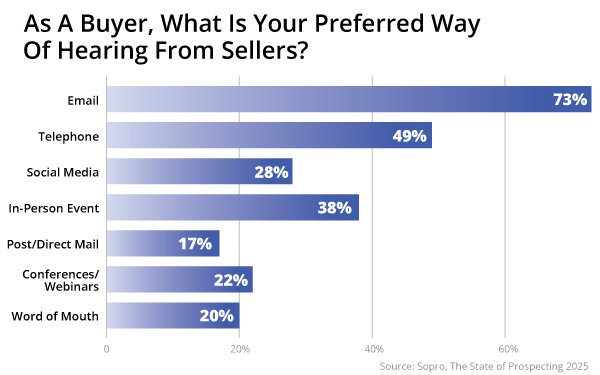
Prospecting has a negative connotation
for some people. But that isn’t stopping 81% of firms in B2B from doing some form of it, judging by The State of Prospecting 2025, a study by Sopro.
Indeed, 70% of B2B companies see prospecting as an essential part of their new business strategy.
Yet prospecting is a more complicated process than newcomers might think, given that
there are now an average of 4.14 stakeholders in the decision-making process, and 7% of businesses involve 10 or more.
Customers and prospects prefer these ways of hearing from sellers:
- Email — 73%
- Telephone — 49%
- In-person event —
38%
- Social media — 28%
- Conferences/webinars — 22%
- Word of mouth — 20%
- Post/direct mail — 17%
advertisement
advertisement
And 75% of businesses say email produces good to excellent ROI.
But don’t think email can do it all. B2B buyers
choose an average of 2.5 channels when asked how they want to be contacted. And 75% of B2B vendors say results are better when multiple prospecting channels are combined, the report states.
How do B2B brands identify prospects? Brands say they:
- Use internal databases — 65%
- Use LinkedIn or other social media platforms —
53%
- Gather contact information from event registrations or trade shows — 38%
- Use a prospecting platform that provides contact
details — 32%
- Rely on referrals and word of mouth — 30%
- Purchase contact lists from third-party vendors —
25%
- Use an agency/freelancer that has its own database — 24%
The most prospected industries are (by percentage of 2024
emails):
- Financial services — 33.7%
- Construction — 9.5%
- Retail —
6.2%
- Insurance — 4.3%
- Real Estate — 4.0%
- Hospitality —
3.7%
- Telecommunications — 3.7%
- IT and Services — 3.0%
- Banking —
3.0%
- Higher Education — 2.4%
The challenges differ between the sales and marketing sides. On the sales side, companies report these
issues:
- Buyers have tighter budgets — 65%
- Increased competition—45%
- Longer time taken before a decision—35%
- Leads go silent without explanation—32%
- Buyers expect sales to do more work/more personalized experiences—28%
The biggest challenges
on the marketing side are:
- Generating enough leads—45%
- Lead quality—42%
- Justifying
spend on brand building over sales activation—28%
Subject lines remain important, and can be used as a way to drive the broader marketing
message. The types of subject lines that are more likely to be opened are:
- Personalized with my name or company name —
66%
- An offer — 62%
- A question — 56%
- Topical/trend/current affairs —
56%
- Humorous — 51%
- Time-sensitive/urgent — 44%
- Intriguing/mystery/clickbait — 43%
- Shocking/alarmist — 29%
Sopro surveyed over 400 senior B2B decision makers and
analyzed billions of data points from a decade of prospecting campaigns.